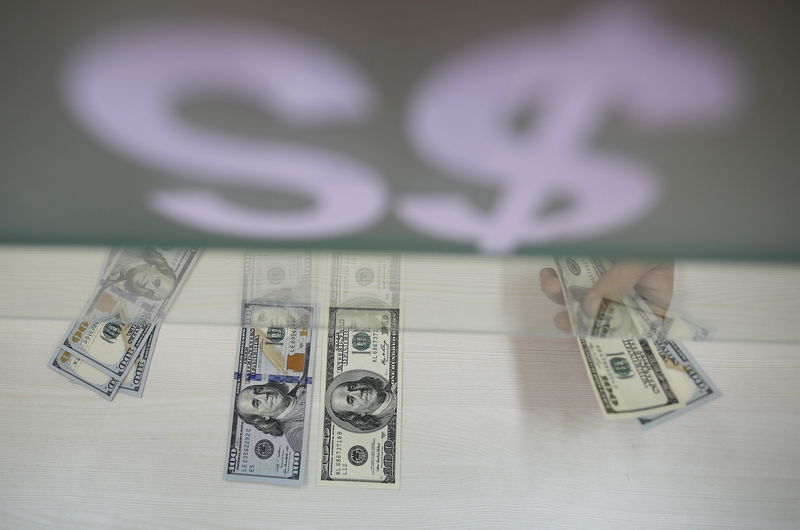(Bloomberg) -- Dislocations in the Treasury-bill curve are getting deeper, with investors becoming more concerned about the U.S. potentially exhausting its borrowing authority as each day passes without a resolution.
Longer-dated bills normally pay higher yields than shorter ones, but that hasn’t been the case lately. Investors have been shying away from bills due in late October and early November -- viewed as most at risk of delayed payment if a legislative agreement on the debt limit isn’t reached. The yield on the Oct. 21 maturity climbed as much as 3 basis points to 0.16% Wednesday, with most bills due earlier and later yielding 0.05% or less.
U.S. Treasury Secretary Janet Yellen said last week that action is needed by Oct. 18, while the Bipartisan Policy Center, a Washington think tank, now projects that the Treasury Department will exhaust its extraordinary measures to avert breaching the debt limit between Oct. 19 and Nov. 2. That compares with a previous BPC calculation of Oct. 15 to Nov. 4.
Senate Majority Leader Chuck Schumer plans Wednesday to hold a vote in his chamber whether to take up a measure approved by the House that would suspend the nation’s debt ceiling until December 2022. Senate Minority Leader Mitch McConnell told a closed meeting of Senate Republicans that he would offer a short-term debt ceiling extension today or an expedited reconciliation process, Punchbowl reports.
Avoiding Bills
If the U.S. runs out of borrowing capacity, debt maturing immediately afterward might not be repaid on time. Investors in those securities are therefore demanding compensation for the risk in the form of higher bill yields.
The backup in Treasury bill yields and recent dislocations in the market -- in some cases by as much as 20 to 25 basis points for potential debt-ceiling risk -- is not inconsequential for securities that have yielded closer to zero for more than a year, according to Deirdre Dunn, managing director and co-head of global rates, at Citigroup (NYSE:C), who spoke on a panel at the Brookings Institution Tuesday.
Still, there seem to be investors willing to buy the dips as yields start to climb, according to JPMorgan (NYSE:JPM) strategist Jay Barry. While Treasury bill yields have risen due to anxiety surrounding a potential default, “there’s been other less constrained investors in a very abundant liquidity world who seem to be stepping in to buy those securities every time they’ve cheapened,” he said during the same Brookings event.
Full Speed Ahead for Reverse Repo
Meanwhile, investors in need of an alternative to certain T-bills are flocking to the Federal Reserve’s facility for reverse repurchase agreements. That’s adding to demand created by T-bill supply cuts made in an effort to keep the debt load under the ceiling. Usage of the facility increased to a record high on Thursday.
Protecting Against Default
The cost to protect against nonpayment over the next year through credit-default swaps has risen to about 27 basis points, from 4 basis points in mid-September. That means it costs 27,000 euros ($31,000) to insure 10 million euros worth of Treasuries against default. The expense reached 45 basis points during the 2015 debt-limit episode, and 80 basis points during the 2011 saga, which resulted in the U.S. losing its top credit rating from S&P.
Smaller Buffer
One of the starkest proxies for debt-ceiling risk is the Treasury’s cash pile. Inflated by fiscal stimulus and Fed asset purchases, the cash balance exploded to a record $1.83 trillion in July 2020, but has since dwindled to around $141 billion, the smallest since August 2019. A large part of that drawdown was mandated by the reinstatement of the debt ceiling at the start of August. But the pile is now well below what the Treasury itself had forecast for the end of the third quarter. The upshot is that the government has less of a buffer to pay its bills if there’s a disruption in debt markets.
Meanwhile, the department said in a statement Friday that around $173 billion of headroom remained as of Sept. 29 under extraordinary measures that have been put in place to avoid the government breaching its debt ceiling, assuming the Debt Issuance Suspension Period ends on Oct. 18.
Still, Wrightson ICAP (LON:NXGN) projects the cash balance will fall below $90 billion by Oct. 6 due to fiscal withdrawals that are concentrated at the beginning of the month, and will have less than $35 billion of unused extraordinary measures remaining on that day.
©2021 Bloomberg L.P.
